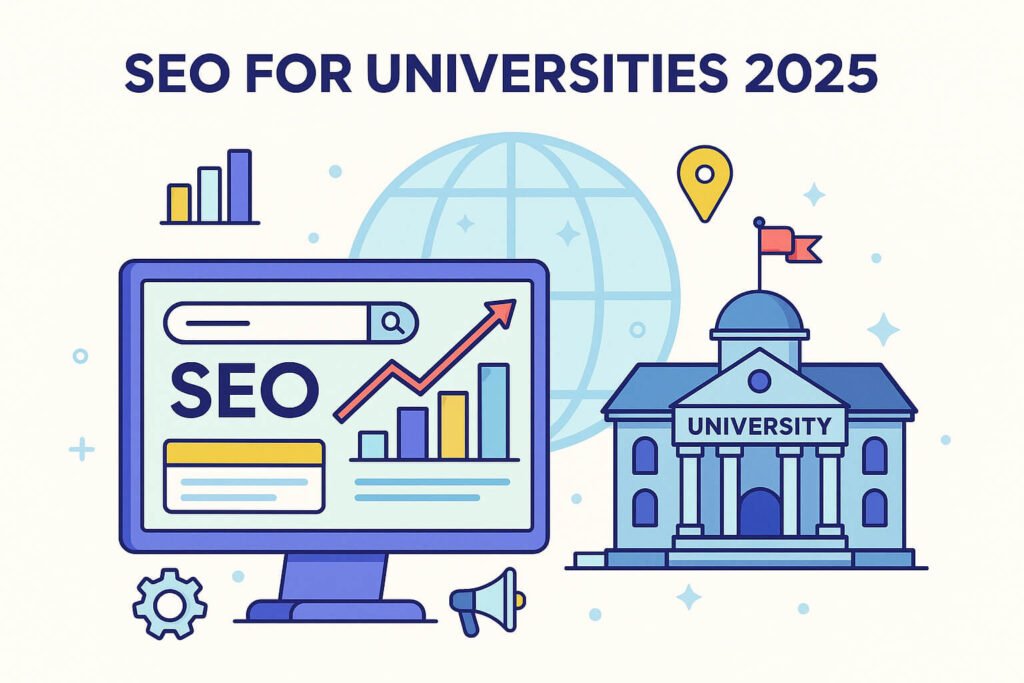The higher education landscape has never been more competitive. Universities and colleges worldwide are not only competing with each other but also with online learning platforms, bootcamps, and international institutions that attract students across borders. In this environment, the ability to stand out online is critical.
Search Engine Optimization (SEO) has become one of the most effective tools for universities and educational institutions to increase visibility, build credibility, and reach prospective students at the exact moment they are searching for academic programs.
As we move into 2025, SEO for universities and educational institutions is evolving rapidly. From voice and visual search to AI-driven personalization, institutions that adopt the latest strategies will have a strong advantage in attracting students both locally and globally.
This article explores the importance of SEO in higher education, the biggest challenges universities face, and the most effective strategies to implement in 2025.

Why SEO Matters for Universities in 2025
- Student Behavior Has Changed: Prospective students no longer rely solely on brochures, fairs, or word of mouth. Instead, they start their journey on Google or YouTube, researching “best universities in Europe for MBA” or “study abroad in Canada 2025.”
- Global Competition: Institutions in the US, UK, Canada, and Europe are competing for international students from Asia, Africa, and Latin America. SEO ensures your programs appear in those searches.
- Long Decision-Making Process: Choosing a university is a long and complex process. SEO enables institutions to engage students at every stage—from awareness to application.
- Credibility & Trust: Ranking highly in search engines increases credibility. If a university consistently appears at the top of search results, students view it as authoritative and trustworthy.
Challenges of SEO for Higher Education
While the benefits of SEO for universities are clear, institutions face unique challenges:
- Intense Competition: Thousands of universities and online programs compete for the same keywords.
- Multiple Audiences: Prospective students, parents, alumni, faculty, and donors all use the website differently.
- Complex Websites: University websites are often large and difficult to optimize, with outdated architecture and slow performance.
- International Targeting: Attracting global students requires multilingual SEO and cultural sensitivity.
- Long Sales Cycle: SEO must sustain interest and nurture leads over months, not just generate one-time conversions.

Key SEO Strategies for Universities and Educational Institutions in 2025
Local SEO for Universities
Even global institutions need strong local visibility:
- Optimize and verify your Google Business Profile for each campus location.
- Use consistent NAP (Name, Address, Phone) information across directories.
- Target keywords like “universities in Boston,” “best colleges in London,” or “MBA programs in Toronto.”
- Collect and showcase reviews from students and alumni.
On-Page SEO Optimization
Every page on a university website is an opportunity to capture student interest:
- Optimize title tags and meta descriptions with education-related keywords.
- Create dedicated landing pages for each program, course, or department.
- Structure pages with clear H1/H2 headings and rich content.
- Incorporate FAQs about admissions, tuition, scholarships, and study life.
Technical SEO for Universities
Large academic websites often suffer from technical issues:
- Improve page speed for both desktop and mobile.
- Ensure mobile-first design (most students search on smartphones).
- Use a clean site architecture with logical navigation.
- Fix broken links, duplicate content, and crawl errors.
- Implement schema markup (Organization, Course, FAQ) for better visibility in search results.
Content Marketing & Blogging
Content remains the backbone of SEO in education:
- Publish blog posts like “Top 10 Engineering Programs in Europe 2025” or “How to Apply for a Student Visa in the UK.”
- Create guides, checklists, and case studies targeted to student queries.
- Use video content—campus tours, alumni interviews, faculty spotlights—optimized for YouTube SEO.
- Showcase success stories of international students.
International SEO
Many universities rely heavily on international students:
- Implement hreflang tags for multilingual websites.
- Translate not just language but also cultural context (e.g., tuition info for US vs. EU students).
- Target international keywords such as “study MBA in Germany 2025” or “top universities in Canada for data science.”
Link Building & Authority Building for Universities
Universities can leverage their strong reputations to build backlinks and authority:
- Partner with academic portals, student forums, and educational blogs.
- Publish research papers and encourage backlinks from Google Scholar or ResearchGate.
- Collaborate with media outlets for PR coverage of achievements.
- Highlight rankings and awards in press releases to attract natural links.
Measuring SEO Success in Higher Education
SEO campaigns must align with university goals. Key performance indicators (KPIs) include:
- Organic traffic growth
- Rankings for priority keywords (e.g., MBA program in Europe, study abroad 2025)
- Completed applications and inquiry form submissions
- Virtual campus tour sign-ups
- Scholarship or financial aid requests
Use Google Analytics 4 (GA4) integrated with a CRM system to track the full student journey—from first click to enrollment.
Global Case Studies
- US College: After implementing an SEO strategy focused on international keywords like “study in the USA,” applications from overseas grew by 120% in one year.
- UK University: By improving technical SEO and launching a content hub on “study abroad tips,” the institution increased organic traffic by 200%.
- Canadian Business School: Optimized MBA program pages and invested in video SEO → 65% increase in global leads.
- European Engineering School: Translated key landing pages into Spanish, Mandarin, and Arabic → applications from international students rose significantly.

SEO Trends 2025 in the Education Sector
- Voice Search: Students increasingly ask voice assistants: “What are the best universities in Europe for data science?”
- AI-Personalized Results: Google’s AI systems prioritize personalized experiences, making relevant content even more critical.
- Visual Search: Prospective students use Google Lens or Pinterest Lens to explore campuses and facilities.
- Competition with Online Platforms: MOOCs like Coursera and edX are competing directly with traditional universities. SEO can help institutions stand out.
How BeeDynamic Helps Universities Win with SEO
At BeeDynamic Group, we understand the unique challenges of higher education SEO. Our strategies are designed to attract, engage, and convert prospective students from around the world.
We offer:
- Comprehensive SEO audits for university websites
- Keyword research focused on high-intent education queries
- Technical SEO for large, complex academic sites
- Multilingual and international SEO strategies
- Content creation and optimization tailored for the student journey
- Transparent reporting linked to student applications and enrollments
Learn more about our services here: SEO Services by BeeDynamic.

Conclusion
In 2025, universities and educational institutions face unprecedented competition for students—locally and globally. SEO is no longer optional; it’s a necessity for survival and growth.
By focusing on local SEO, technical improvements, content marketing, link building, and international strategies, institutions can dramatically increase their visibility and credibility online.
At BeeDynamic, we help universities stay ahead of the curve, attract qualified applicants, and build a sustainable online presence that drives real results.
Contact us today to learn how we can help your institution thrive with SEO for universities and educational institutions in 2025.



